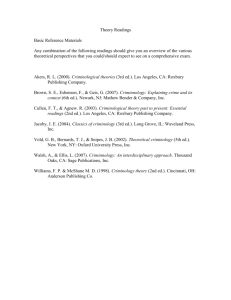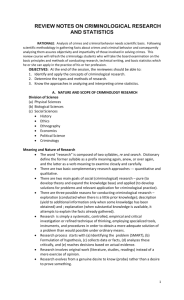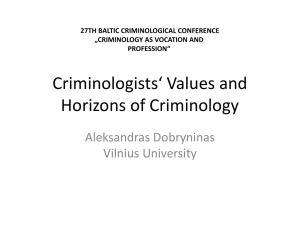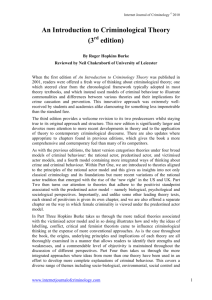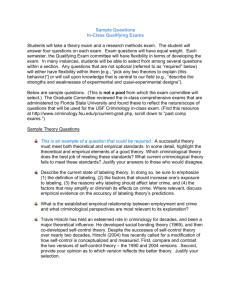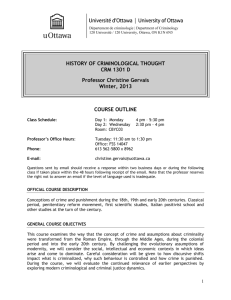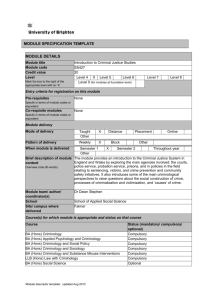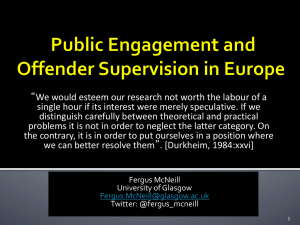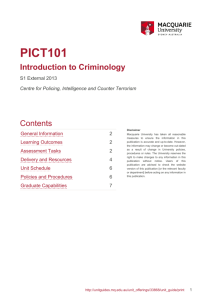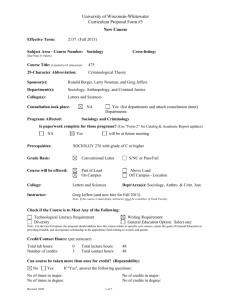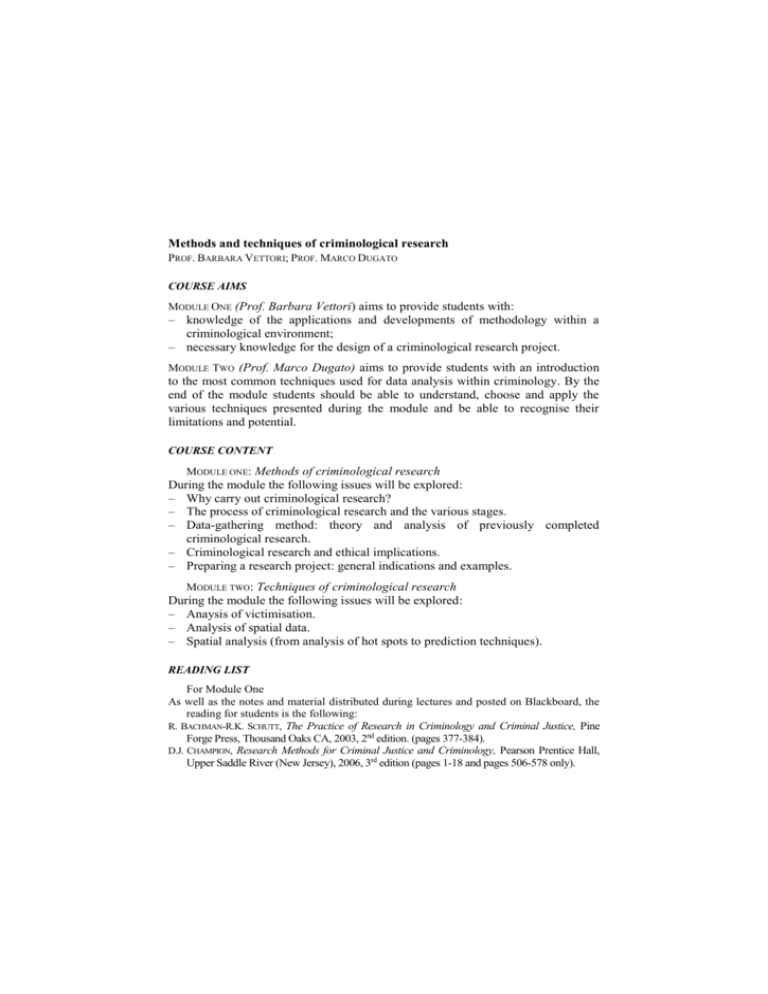
Methods and techniques of criminological research
PROF. BARBARA VETTORI; PROF. MARCO DUGATO
COURSE AIMS
MODULE ONE (Prof. Barbara Vettori) aims to provide students with:
– knowledge of the applications and developments of methodology within a
criminological environment;
– necessary knowledge for the design of a criminological research project.
MODULE TWO (Prof. Marco Dugato) aims to provide students with an introduction
to the most common techniques used for data analysis within criminology. By the
end of the module students should be able to understand, choose and apply the
various techniques presented during the module and be able to recognise their
limitations and potential.
COURSE CONTENT
MODULE ONE: Methods of criminological research
During the module the following issues will be explored:
– Why carry out criminological research?
– The process of criminological research and the various stages.
– Data-gathering method: theory and analysis of previously completed
criminological research.
– Criminological research and ethical implications.
– Preparing a research project: general indications and examples.
MODULE TWO: Techniques of criminological research
During the module the following issues will be explored:
– Anaysis of victimisation.
– Analysis of spatial data.
– Spatial analysis (from analysis of hot spots to prediction techniques).
READING LIST
For Module One
As well as the notes and material distributed during lectures and posted on Blackboard, the
reading for students is the following:
R. BACHMAN-R.K. SCHUTT, The Practice of Research in Criminology and Criminal Justice, Pine
Forge Press, Thousand Oaks CA, 2003, 2nd edition. (pages 377-384).
D.J. CHAMPION, Research Methods for Criminal Justice and Criminology, Pearson Prentice Hall,
Upper Saddle River (New Jersey), 2006, 3rd edition (pages 1-18 and pages 506-578 only).
F.E. HAGAN, Research Methods in Criminal Justice and Criminology, Allyn & Bacon, Boston,
2005, 7th edition (limitatamente a pages 1-32, pages 442-446 and pages 468-478 only);
W. LAWRENCE NEUMAN-B. WIEGAND, Criminal Justice Research Methods: Qualitative and
Quantitative Approaches, Allyn and Bacon, Boston, 2000 (pages 10-13 only).
For distance-learning students:
F.E. HAGAN, Research Methods in Criminal Justice and Criminology, Allyn & Bacon, Boston,
2005, 7th edition (the whole book).
For Module Two
Recommended reading to supplement material distributed during lectureses:
MICHELLE ROGERSON, Crime Incidence, Prevalence and Concentration in NDCs: Implications for
Practice, Centre for Regional Economic and Social Research, November, 2004.
SHANE D. JOHNSON AND KATE J. BOWERS, ‘The Burglary as Clue to the Future The Beginnings of
Prospective Hot-Spotting’, European Journal of Criminology, 1 (2004), 237–55
CHARLES W OSTROM, Time Series Analysis: Regression Techniques, SAGE, 1990.
SPENCER CHAINEY AND JERRY RATCLIFFE, GIS and crime mapping, Wiley, 2005.
L. ANSELIN-E. GRIFFITHS-G. TITA, Crime mapping and hot spot analysis, in Environmental
criminology and crime analysis, Willan Publishing, 2009 (pp. 97-117).
JOHN ECK ET AL. (EDS), Mapping Crime: Understanding Hotspots, National Institute of Justice, 2005
L. ANSELIN, An Introduction to spatial autocorrelation analysis with GeoDa, 2003.
M. WARD-K. GLEDITSCH, Spatial regression models, SAGE, 2008.
Additional reading or supplementary material will be available on Blackboard, students are
recommended to consult it on a regular basis.
TEACHING METHOD
MODULE ONE
Lectures; exercises on completed criminological studies, in order to identify the design
of the research; group work on the preparation of research projects within a criminological
environment.
MODULE TWO
Lectures will be held in computer halls and theoretical will be alternated with practical
exercises. During the module students will be provided with data-analysis analysis software.
ASSESSMENT METHOD
MODULE ONE
Oral examination.
MODULE TWO
Full-time students (at least 80% of lectures) are required to submit an individual paper
on completion of the course and sit a supplementary test during the course. Distancelearning students are required to pass a written test as well as submit an individual paper.
More details will be provided during lectures and can be found in the syllabus.
NOTES
Further information can be found on the lecturer's webpage at
http://docenti.unicatt.it/web/searchByName.do?language=ENG or on the Faculty notice
board.

